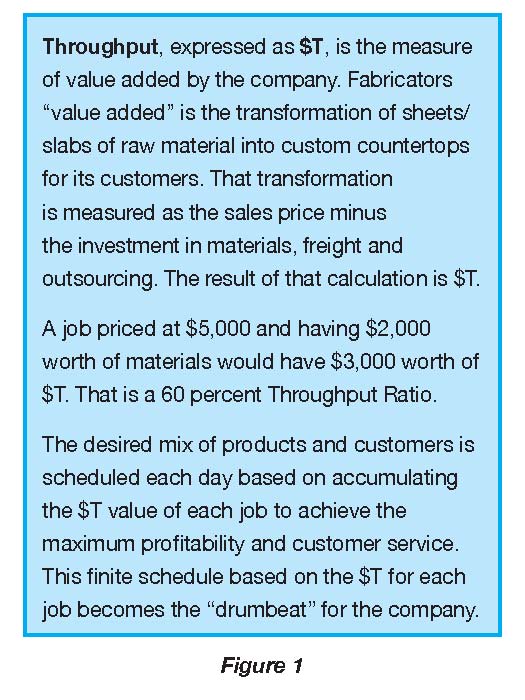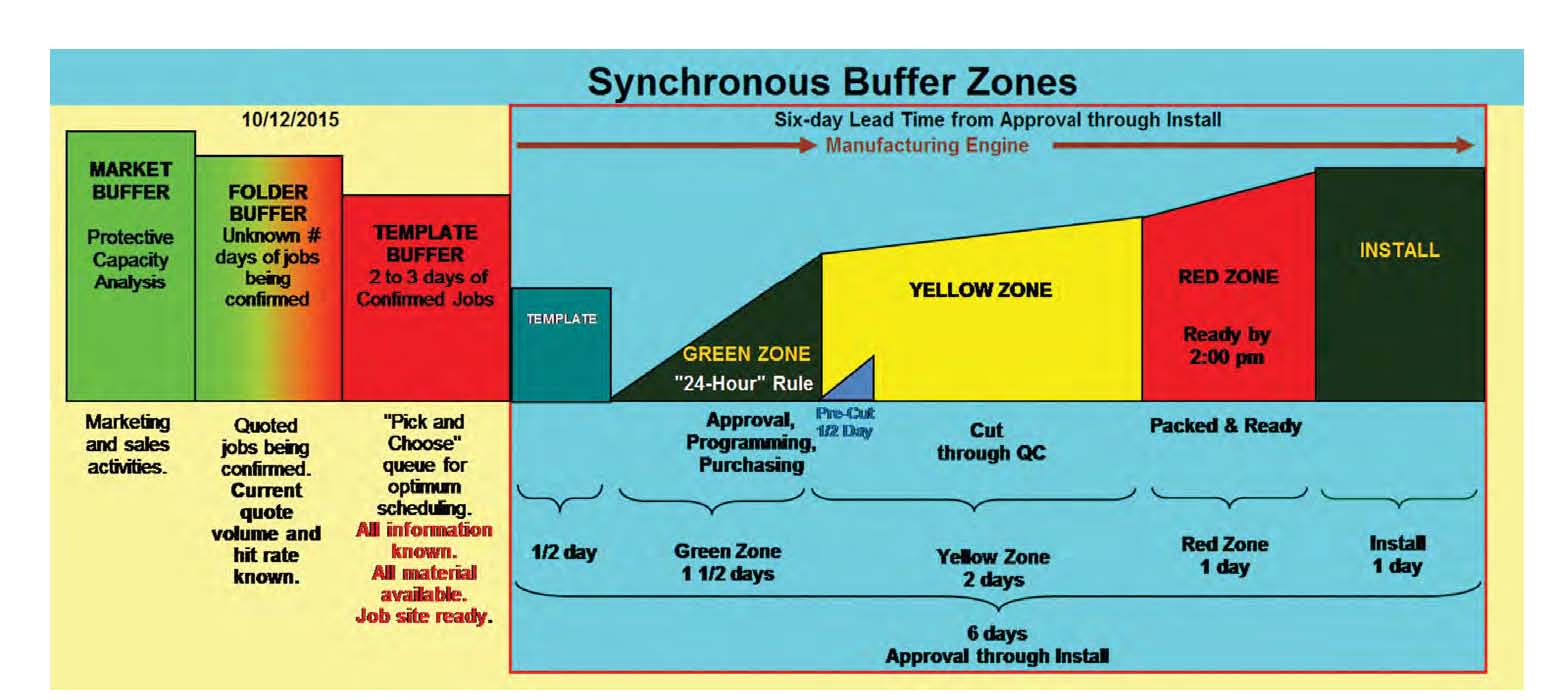|
Synchronous Flow: Helping the Countertop Fabricator to synchronize the business system By Ed Hill
The Control Point is finitely scheduled each day based on its capacity to produce throughput ($T). All other functions in the company from sales through manufacturing, and including all the support functions, operate to serve the Control Point. Every function in the company is synchronized around the Control Point. To manage the daily operations in a proactive (rather than reactive) manner, companies use another key element of Synchronous Flow called Buffer Management. The idea behind Buffer Management is recognition that there will be problems in the normal workday. Material issues, customer information issues, quality issues, equipment issues, people issues, etc. are inevitable, and the business system must be prepared to deal with them. Designing into the business process a method to manage proactively is much better than constantly “fighting fires” with little effort toward preventing them in the first place. The disciplines of Buffer Management bring those virtues to the operations of the business enterprise. Buffer Management is accomplished by dividing all business operations into sequential “zones” reflecting a “time scheduling” approach for controlling the jobs as they move through the business system. Based on the date of install (or ship, deliver, pickup), each job is planned for a certain buffer zone location each day. As jobs are processed, management can monitor the status of each and can identify actions required to assure that each one can meet its schedule. Overall, Buffer Management brings a system of control to the process by optimizing the volume of WIP within each zone on a continuous basis. As a process of accountability, the first issue to be discussed in the agenda of each Buffer Management meeting is the follow-up on all assignments of the previous day. Assigned persons simply report that they have (or have not) completed the resolution of the identified issue. How it was accomplished is not reported, only that it has been resolved. If a resolution is not complete, a new assignment (possibly the same person, possibly not) is made. In this manner, no issue can “fall through the cracks” and cause more serious problems for the company as it is compounded over time. During the meeting, the current status of the business is reported including performance relative to preset goals in daily throughput ($T) for each product line. Current, actual lead times in manufacturing from template through install and from cut through install are reported for each product line. The amount of work yet to enter manufacturing, expressed in elements of time and throughput dollars, is reported indicating the demand in the coming weeks for each product line. At the conclusion of these brief reports, everyone present knows the current business status, updated each day of the month, relative to the performance goals and the coming demand within each product line. Then, the status of each buffer zone is reported by the person in charge of each area. A “hole” is reported if a job is not in the position within the process that it should be according to the scheduling process. The zone location of the issue in question determines its priority for action. A “buffer hole” in the Red Zone will affect the Control Point in a few hours, whereas a “hole” in the Green Zone will not affect the Control Point for several days. Therefore, assignments are made and proactive actions are planned with these priorities in mind. A review of the Buffer Management Log Book, in which a brief description of each “issue” is recorded, will allow identification of the most chronic issues for a managed effort to truly solve the problem and prevent the issue from reoccurring. The test for effectiveness is that the identified issue does not reappear in the records of the Buffer Management Log Book in succeeding months. This approach will address the issues that are occupying the valuable time of the operations people and the management staff. As the most serious of these are solved, the time that those issues required is converted into planning time during which proactive management is accomplished. Inevitably, the stress levels of the staff is reduced, and a sense of calmness and control is introduced into the daily routine. Users of the Synchronous Flow system report that the quality of life improves for them. Others report that an extraordinary period of growth was accomplished only because the business practiced the principles of Synchronous Flow and used the planning tools it provides to grow intelligently and profitably. Throughput Accounting The fundamental metric of that approach is throughput ($T), which is defined as the measure of value added by the company. All manufacturers simply transform raw materials into finished products. That transformation can be measured as the throughput of the business. For any order or for any period of time, the sales revenue value of the finished products, less the cost of the materials, freight and outsourcing in those products, equals $T. Using this basic metric, the business system can be managed to an optimum mix of products, customers and market segments toward a predetermined financial goal. In the effective Synchronous Flow business system, every key person is aware of the current $T goals and understands the $T value of each job. The common language of daily communication becomes $T rather than square feet, sales value or numbers of jobs. All of the management metrics are based on $T rather than cost or efficiency statistics. Throughput Accounting focuses on revenue generation, not product costing. As such, it focuses on the positive potential of a company (the generation of wealth) and not on the reduction of costs. That is not to say that good stewardship of resources is ignored. It’s just that the focus is on generating revenue, not cutting costs. The amount of $T planned for each day in each product line is a calculated amount that considers three very important factors necessary in effective business planning: ■ Market demand In the ideal world, and that which the Synchronous Flow system seeks, there is alignment in all three of these elements. In that situation, customers are being satisfied, the manufacturing system is in control, and the company is making money. Daily Synchronous Flow reports make known the performance status of the company relative to the published goals on a real-time basis. Overall company performance status can be posted daily in the form of a Productivity Score, which reflects the ratio of $T generated relative to the operating expense of the business. This means that managers can know the status of performance every day rather than after the financial statements are prepared several weeks into the following month. Because the Productivity Score does not reveal sensitive financial information, it can be shared with the workers and can be used as a primary motivational tool by the operations managers. Another important principle of Synchronous Flow is the importance to establish and maintain Protective Capacity within all the functions upstream and downstream of the Control Point. Protective Capacity is additional capacity at each resource step planned for absorption of the inevitable delays, mistakes and confusions that occur during the work day. The system’s capacity must be unbalanced. This is one of the “counter intuitive” elements of Synchronous Flow. The idea is that it is essential to plan for the necessary capacity to absorb the “attacks by Murphy” that are sure to occur. Protective Capacity is not “excess capacity,” which implies waste; rather it is essential capacity required for a smooth and predictable process flow. Protective Capacity does not increase costs; it provides opportunity for creation of more $T. Maintaining the planned amount of Protective Capacity at all times allows a company to: ■ Achieve and maintain short lead times The Synchronous Flow Protective Capacity Planning Report is the tool to use in planning for profitable growth. Kept up to date, this report indicates the current status of the business plan and will allow a “what if” analysis to check the effects of most any action. It is the long-term planning tool for the business. It allows proactive management of the demand growth in the coming months. It is the essence of planning using the Synchronous Flow business system. It’s All About Behaviors Total process lead times are fully controllable at one week from template through install. As needed, the lead times can be reduced even further. Most importantly, speed and reliability of the quoted lead times improve. Results It is important to note that transformation to Synchronous Flow is not an easy task. Effective use of the principles means that essentially every employee in the company will be affected by the process changes. While the essential elements are standard within the Synchronous Flow approach, each implementation will be specifically customized to apply to the particular processes and unique features of each company. About the Author Ed Hill is president of Synchronous Solutions (www.SynchronousSolutions.com), and is based in Charlotte, N.C. He can be reached at [email protected] or (704) 560-1536. |


